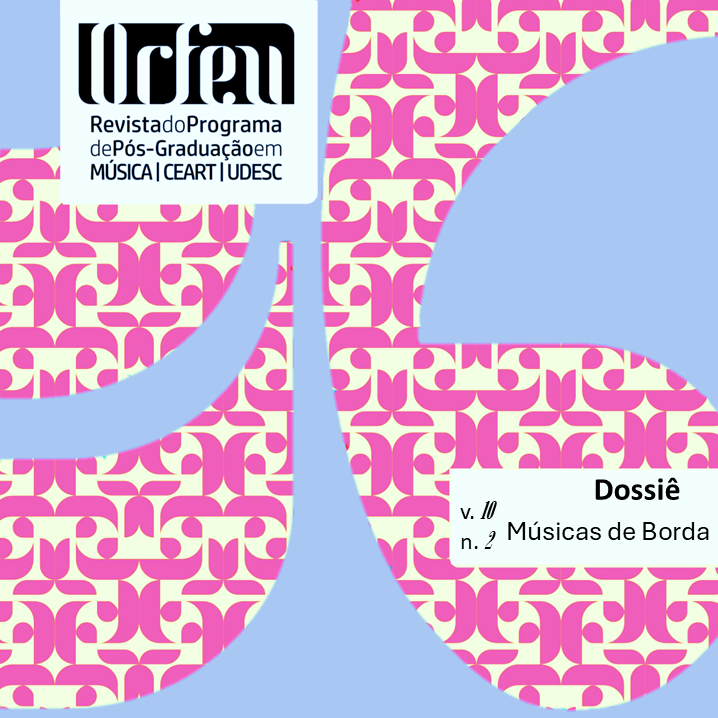On Tremolo and Guitar Tremolo
A Study of Two Original Works, Cinéticas de Io and Escritos no Pó
DOI:
https://doi.org/10.5965/2525530410022025e0103Keywords:
trêmulo, violão, composição musicalAbstract
This article investigates the tremolo technique on the guitar, considering its theoretical, compositional, and performance-related implications. The study is based on the analysis of two original works—Escritos no Pó (2023), for guitar and electronics, and Cinéticas de Io (2024), for eight-string guitar. It begins by addressing the concept of tremolo in music theory and its practical variations across different instrumental families, highlighting its value as a timbral resource and as a solution to certain instruments’ technical limitations, such as sustaining long notes. The discussion then turns to the guitar-specific technique, presenting it as possessing broad expressive potential, capable of producing complex textures and expanding the instrument’s polyphonic possibilities. Finally, the analysis of the works demonstrates the role of tremolo as a unifying and structuring element in the compositional process, while also suggesting new directions for its exploration in contemporary music. This study aims to contribute to guitarists, composers, and researchers by offering an integrative approach that bridges practice and theory.
Downloads
References
ADLER, Samuel. The Study of orchestration. New York: W/ W Norton & Company. 1989.
AGUADO, Dionísio. Nuevo Método para Guitarra. Madri: Lodre. 1843.
BOUCOURECHLIEV, André. A linguagem musical. Lisboa: Edições 70. 1993.
BELLINATI, Paulo. The greats guitarrists of Brazil: the guitar works of Garoto. v. 1. San Francisco: Guitar Solo Publications. 2002.
DOTTO, Evandro. Os 17 Estudos Expressivos de Geraldo Ribeiro: uma abordagem com foco no uso de técnicas expandidas e no idiomatismo. Belo Horizonte: Universidade Federal de Minas Gerais (Dissertação). 2021.
GÓES, Alexandre Magno Abreu de. O emprego do Imalt como solução interpretativo composicional em 3 obras autorais para violão. Dissertação (Mestrado). Escola de Música, Universidade Federal do Rio Grande do Norte, 2015.
GOULD, Elaine. Behind bar: The definitive guide to music notation. Londres: Faber Music. 2011.
MERZERO, Ainhoa; ORDOÑANA, Jose; LAUCIRICA, Ana. El vibrato vocal en el proceso de enseñanza-aprendizaje del canto. Zulia: Opción, Año 31, No. Especial 6 . p. 591 – 610. 2015.
MED, Bohumil. Teoria da música. Brasília: Musimed. 4 ed. 1996.
OLIVEIRA, Cristiano Braga de. A “Escola Tárrega”: uma nova pedagogia do violão. Revista Vórtex, v.8, n.3, p. 1-33, 2020.
PUJOL, Emílio. Escuela Razonada de la Guitarra. v. 1. Buenos Aires: Ricordi Americana. 1956.
PUJOL, Emílio. Escuela Razonada de la Guitarra. v. 4. Buenos Aires: Ricordi Americana. 1971.
RODRIGUES, Flávio. [total flamenco] #tremolo - #técnicaexpress - #violão #flamenco #guitarraflamenca. Youtube, 18 de agosto de 2019. 3’06’’. Disponível em https://www.youtube.com/watch?v=ZkntUAadXBo. Acesso: 21 de junho de 2025.
ROSEN, Charles. Beethoven’s piano sonatas. New Haven: Yale University Press. 2002.
SHENA, Roger D; ARAÚJO, Fernando. A arte do trêmulo: análise histórica, técnica e levantamento de novas possibilidades interpretativas. Anais do PERFORMUS23. XI Congresso Internacional da Associação Brasileira de Performance Musical. 2023. p. 174-181.
SICCASGUITARS. The Mystery Behind Ana Vidovic's Tremolo Technique. Youtube, 23 de março de 2023. 3’54’’. Disponível em https://www.youtube.com/watch?v=92FaULFFMag. Acesso: 23 de junho de 2025.
STEFAN, Gilberto. O uso do trêmolo como técnica estendida no violão contemporâneo. Florianópolis: Anais do XX Congresso da ANPPOM: A pesquisa em música no século XXI: trajetórias e perspectivas, 2010. p. 1244-1249.
WOLFF, Daniel. Aperfeiçoando a execução do tremolo. Assovio – Periódico da Associação Gaúcha do Violão. v. 1, n. 4. Porto Alegre. 2000.
Downloads
Published
How to Cite
Issue
Section
License
Copyright (c) 2025 Felipe Mendes Vasconcelos

This work is licensed under a Creative Commons Attribution 4.0 International License.
Authors who submit their manuscripts to be published in this journal agree to the following terms:
1. Authors retain the copyright and grant to the journal the right of first publication, whilst simultaneously permitting their work to be licensed under the Creative Commons License Attribution, which allows the sharing of work with recognition of the authorship and initial publication in this journal.
2. Contributions in this journal are open access; this means they are based in free use, and non-commercial applications.






